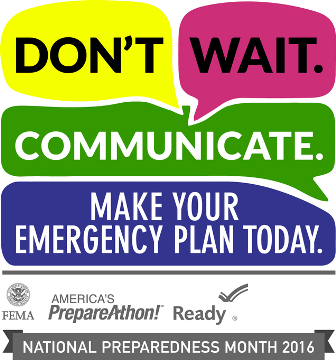 September Is National Preparedness Month
September Is National Preparedness Month
Get Prepared for the Prepare-A-Thon on September 30
September is National Preparedness Month which serves as a reminder that we all must take action to prepare, now and throughout the year, for the types of emergencies that could affect us where we live, work and also where we visit.
On September 30, America’s Prepare-A-Thon takes place. This is a grassroots campaign to urge us to increase community preparedness and resilience. Join others around the country to practice your preparedness. Please visit https://community.fema.gov to find out where preparedness events are happening in your community.
The most important step to being prepared for an emergency is to make an emergency communication plan. Your family may not be together if a disaster strikes, so it's important to think about the following situations and plan just in case. Consider the following questions when making a plan:
- How will my family get emergency alerts and warnings?
- How will my family get to safe locations for relevant emergencies?
- How will my family get in touch if cell phone, internet or landline doesn't work?
- How will I let loved ones know I am safe?
- How will my family get to a meeting place after the emergency?
Here are a few easy steps to start your emergency communication plan:
- Understand how to receive emergency alerts and warnings. Make sure all household members are able to get alerts about an emergency from local officials. Check with your local emergency management agency to see what is available in your area and learn more about alerts by visiting www.ready.gov/alerts.
- Discuss family plans for disasters that may affect your area and plan where to go. Plan together in advance so that everyone in the household understands where to go during a different type of disaster like a hurricane, tornado or wildfire.
- Collect Information. Create a paper copy of the contact information for your family that includes phone (work, cell and office), email, social media, medical facilities, doctors, service providers and school.
- Identify information and pick an emergency meeting place. Decide on safe, familiar places that are accessible for all household members (including those with disabilities and/or pets or service animals). Examples may include a mailbox at the end of the driveway or a neighbor's house, library, community center or family friend's home. Make sure everyone knows the address of the meeting place and discuss ways you would get there.
- Share the information. Make sure everyone carries a copy in his/her backpack, purse or wallet. You should also post a copy in a central location in your home.
- Practice your plan. Have regular household meetings to review your emergency plans, communication plans and meeting place after a disaster, and then practice just like you would a fire drill.
You can find examples of emergency plans at www.ready.gov/make-a-plan
Sources: www.ready.gov and https://community.fema.gov


